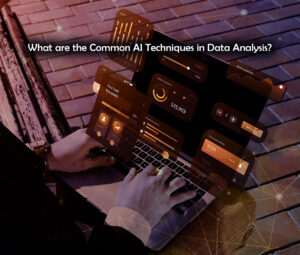Artificial intelligence is rapidly gaining popularity in various applications. But how does it contribute to data analytics? A Gartner report predicts that by 2030, the majority of future AI models will be trained using synthetic data.
In this article, we’ll explore five distinct ways to leverage AI in data analysis, utilizing common tools in the field. These methods offer practical applications that you can easily implement. Keep reading to discover these unique approaches!
What is AI in Data Analysis Mean?
AI in data analysis involves applying artificial intelligence (AI) to analyze extensive sets of data. This application enables data analysts and scientists to identify patterns and understand the behavior of consumers or other datasets. Utilizing robust machine learning algorithms, AI plays a crucial role in swiftly and accurately making sense of vast amounts of information.
AI plays a crucial role in automating various processes. Instead of relying on human effort for exhaustive tasks, businesses can train computer programs to handle complex operations. AI, simulating human intelligence, excels in recognizing trends and learning from the data it processes, providing accurate results.
It’s essential to distinguish between data analytics and analysis in this context. While these terms are often used interchangeably, data analytics is a subset of business intelligence. It employs machine learning to unearth new insights from the data.
Also Read: A Beginner’s Guide to AI in Cybersecurity: What You Need to Know
What are the Common AI Techniques in Data Analysis?
 When it comes to AI analysis, there are different methods to choose from based on your needs. Here are a few common AI techniques:
When it comes to AI analysis, there are different methods to choose from based on your needs. Here are a few common AI techniques:
- Machine Learning: AI uses machine learning to process a lot of data and find patterns. For example, it can analyze social media posts to understand people’s feelings. The more data it gets, the better it becomes at predicting trends or giving useful information.
- Natural Language Processing (NLP): NLP helps computers understand human language. AI reads a lot of text to learn the meaning of words and how to respond to what people say. This helps AI analyze text, create new content, or summarize information.
- Computer Vision: Computer vision is about how computers “see” and understand images and videos. AI using computer vision can analyze lots of image and video content to find patterns. It can recognize movement, identify faces, and pull information from images.
How Can AI be used in Data Analysis?
 Now that we are familiar with the idea of AI in data analysis, let’s see exactly how it can be used.
Now that we are familiar with the idea of AI in data analysis, let’s see exactly how it can be used.
- Generating Code & Debugging:
- AI tools like DataCamp Workspace AI, Anaconda Assistant, Jupyter AI, and GitHub Copilot assist in creating and debugging code for tasks like visualizing large datasets and building machine-learning models.
- They can automate code generation, provide code completions, and debug errors, saving time on documentation.
- Explaining AI in Data Analysis & Insights:
- AI tools like Tableau GPT help explain data points and provide deeper insights into data analytics.
- Users can ask straightforward questions about trends or correlations in datasets, aiding in exploratory data analysis.
- Creating Synthetic Data:
- AI is utilized to generate synthetic data, beneficial for machine learning engineers and data scientists.
- Tools like ChatGPT, Mostly AI, or Gretel AI help create training datasets, facilitating the testing of different models.
- Creating Dashboards & Reports:
- AI-driven tools such as Tableau GPT can quickly aggregate data into user-friendly dashboards or reports.
- Midjourney AI offers inspiration for creating visually appealing charts and dashboards.
- Automated Data Entry from Images:
- AI automates data entry from images or documents, useful for Excel users.
- Features like “insert data from the picture” in Excel use computer vision to convert images into digital datasets, saving time, especially in industries like healthcare processing X-rays or MRIs.
Future Trends in AI and Data Analytics Simplified
AI and data analytics go hand in hand, and in the future, they’ll work together even more. AI will play a bigger role in understanding data, like finding patterns and getting insights from big sets of information.
We’ll likely see improvements in making reports automatically, and more use of NLP (natural language processing) to ask questions in everyday language, making data easier to understand.
Moreover, AI in data analysis will become crucial in keeping data safe, especially as companies store more personal information. AI tools can spot strange behavior or patterns that might mean bad activity, helping to keep user data safe from cybercriminals.
Winding Up
AI’s role in data analytics is growing more widespread due to its advantages in speed, data validation, democratization of data, and automation.
The future of AI in data analysis holds promise, with ongoing developments in various tools and applications. These range from coding for data analysis, explaining findings, generating synthetic data, and designing dashboards, to automating data entry.


